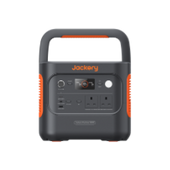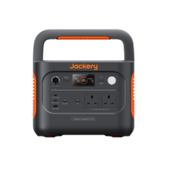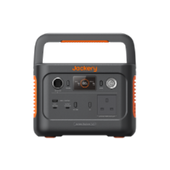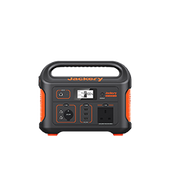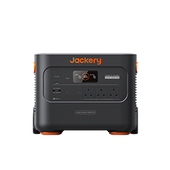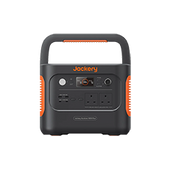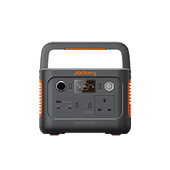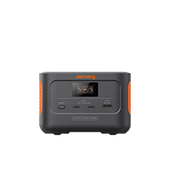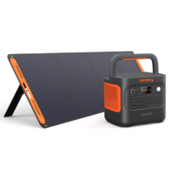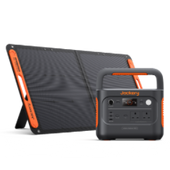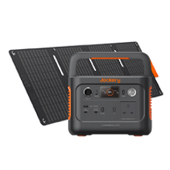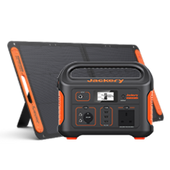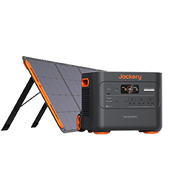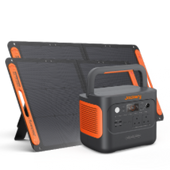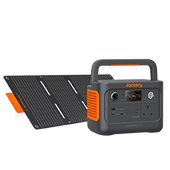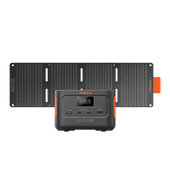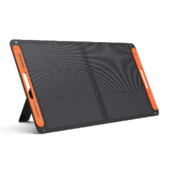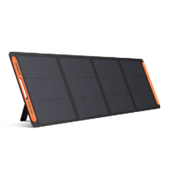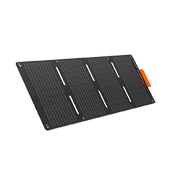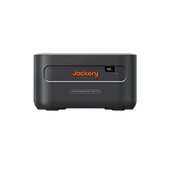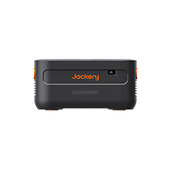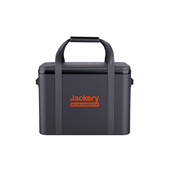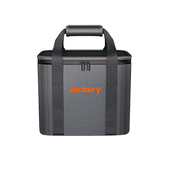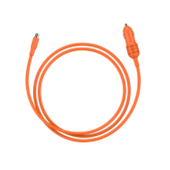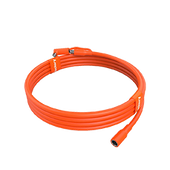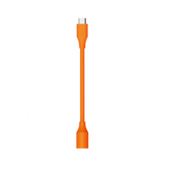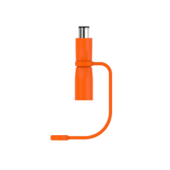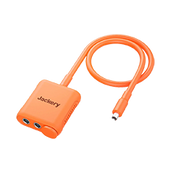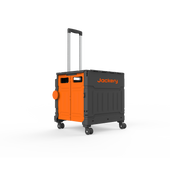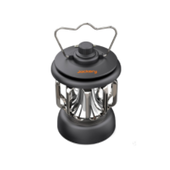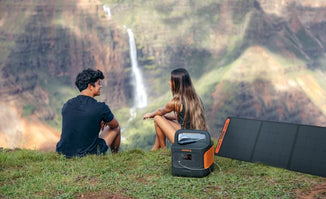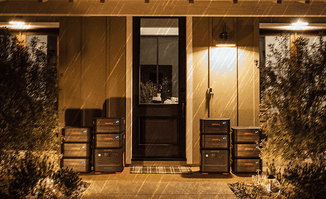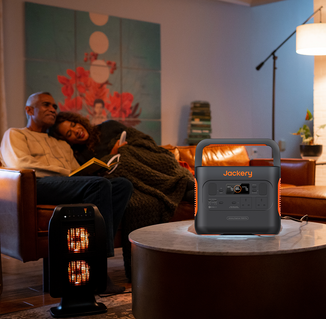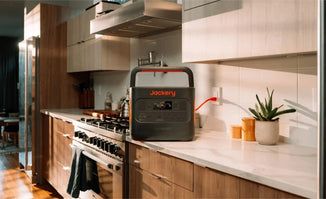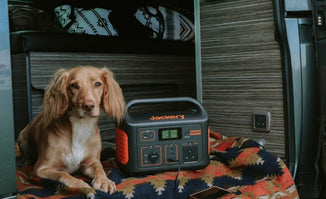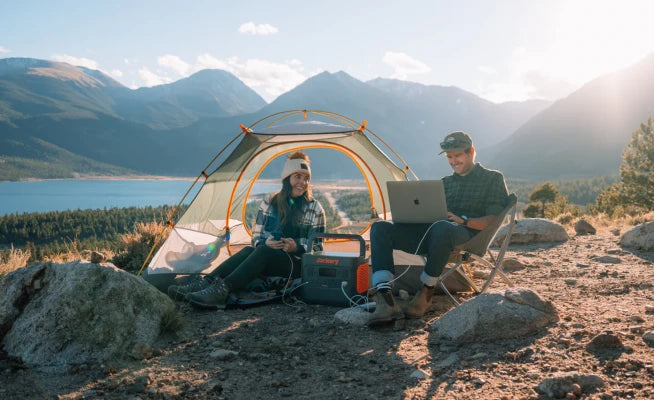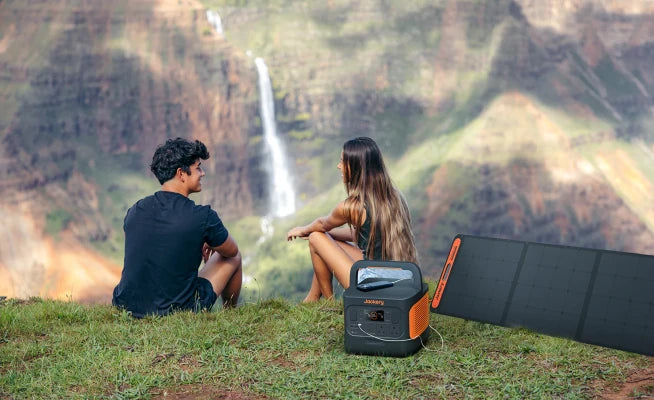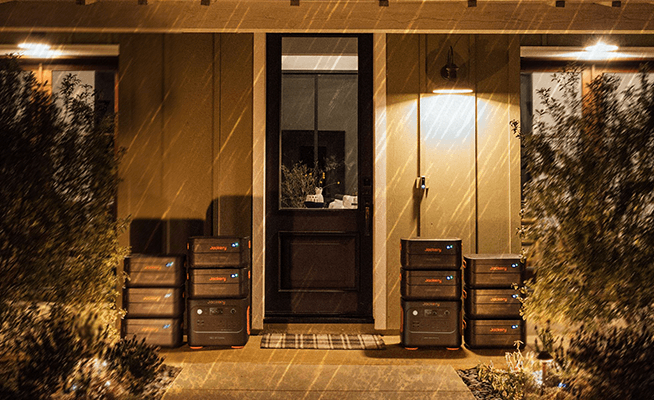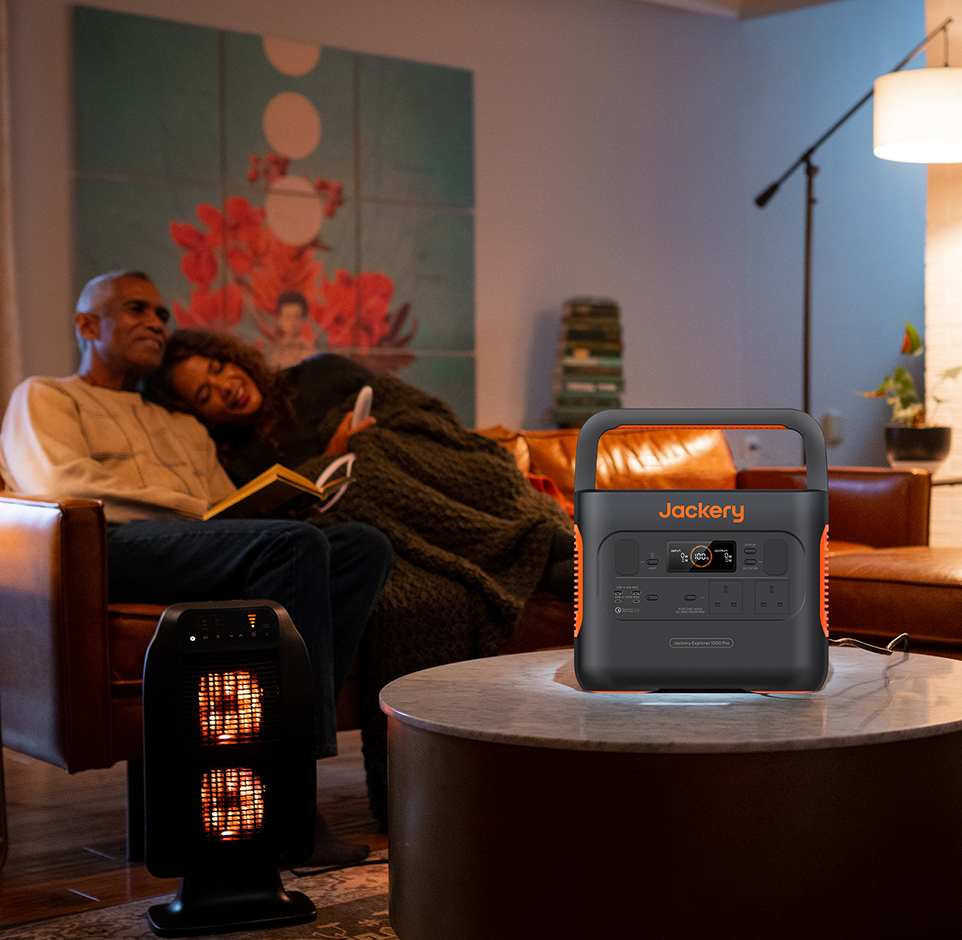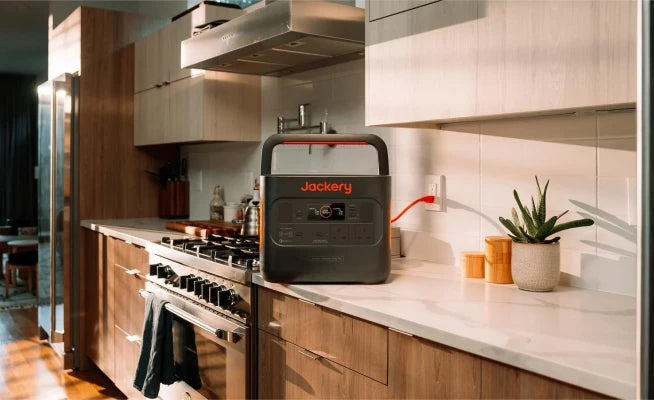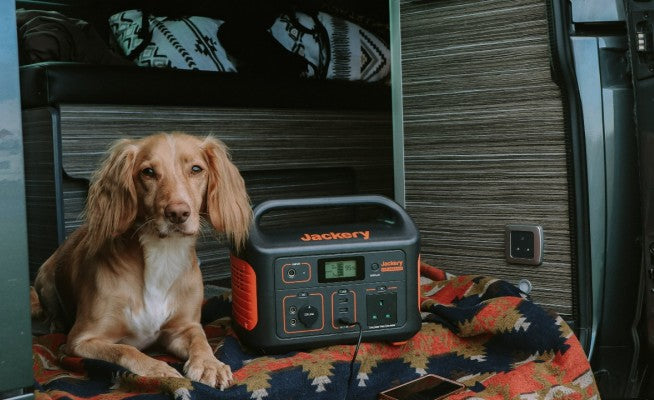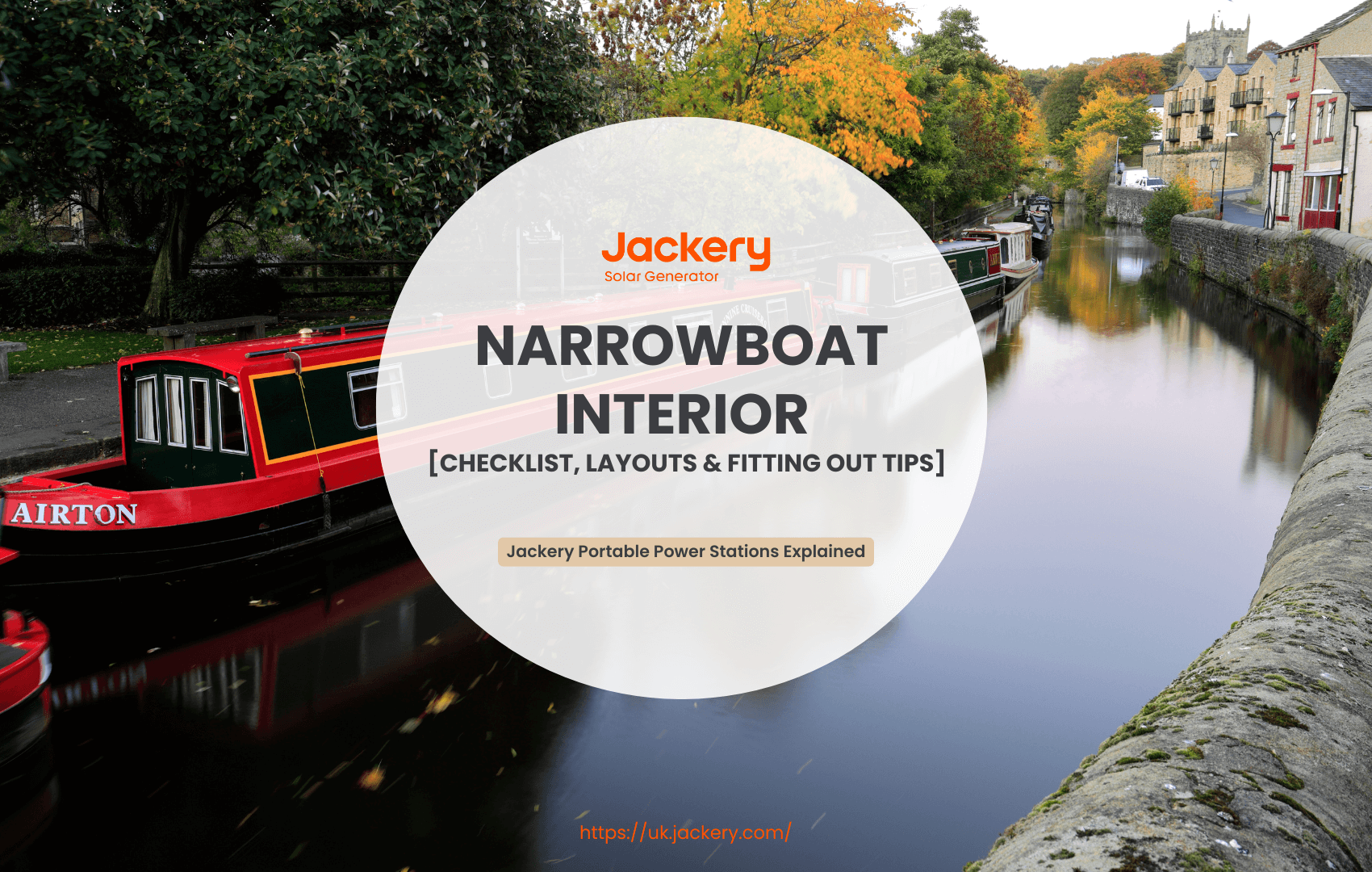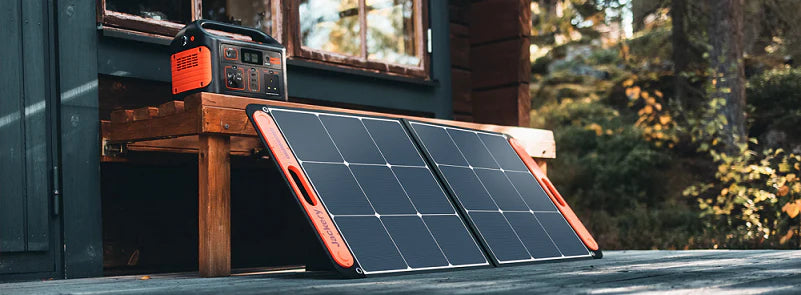Living on a narrowboat provides a unique, tranquil lifestyle ideal for those who enjoy adventure and simplicity. Whether you want to kit out your own boat, design a pleasant cabin, or explore the waterways by hiring, this book has all you need to know.
We'll lead you through a simple checklist for narrowboat interior design, thoughtful layout ideas, and expert recommendations to make your job go more smoothly. Discover the finest places to buy or hire a narrowboat in the UK. Prepare to enjoy life on the canals with confidence and inspiration!
Besides, living on a boat is inconvenient, especially for electricity. So, we highly recommend Jackery Portable Power Station to power your appliances with higher capacity and portability.
|
Key Takeaways: |
|
- Always start fitting out your narrowboat with a clear checklist covering insulation, wiring, plumbing, and safety essentials. - Assess your DIY skills honestly before committing to a complete narrowboat fit-out project. Invest in high-quality materials and reliable tools to ensure your narrowboat lasts many years. - Make sure your fit-out meets all UK legal and safety standards, including RCD compliance and gas inspections. - Hiring a narrowboat is easy even for beginners, with most companies providing complete instruction and beginner-friendly routes. - We recommend Jackery Explorer 2000 v2 and 1000 Plus portable power stations to power your narrowboat appliances effectively. |
Checklist for Fitting Out a Narrowboat
Fitting out the interior of a narrowboat is a thrilling project that combines creativity, functionality, and a spice of adventure. Whether you intend to live onboard full-time or simply wish to construct a peaceful hideaway on the water, the process demands careful consideration of space, safety, and elegance.
With limited space, every decision—from layout and insulation to plumbing and furniture—is critical to making your narrowboat functional and comfortable. In this guide, we've developed a complete checklist to assist you with the fit-out process, ensuring you get the most out of your boat's interior while adhering to UK legislation and standards.

A. Planning & Design
Planning and designing the interior of a narrowboat requires careful consideration due to the limited space and unique environment.
Layout Design: You should begin by choosing a layout for your narrowboat interior. A traditional layout often includes a forward saloon, galley, bathroom, and bedroom. At the same time, contemporary designs might feature an open-plan design with multifunctional areas to maximise the use of limited space.
Space Optimisation: It's essential to think about how to use space efficiently on a narrowboat. You can achieve this by incorporating space-saving furniture and clever storage solutions that maximise every inch available.
Style & Theme: You'll need to decide on your interior's overall style and theme. Consider the colour schemes, materials, and finishes that reflect your personal style and contribute to a comfortable and functional living space.
B. Structural & Insulation Work
Proper insulation is critical for keeping a suitable internal temperature in both hot and cold weather, preventing condensation, and enhancing overall living conditions.
Insulation: Proper insulation is crucial for preserving comfort aboard a narrowboat. Applying thermal and acoustic insulation helps to manage the temperature inside and decreases noise from the engine and surrounding surroundings.
Lining: You will want to line the interior with appropriate materials. Plywood or tongue-and-groove lumber are popular options for a traditional style. However, modern panels can provide a sleek, contemporary finish.
Joinery: You can design unique joinery to meet your specific requirements. This includes custom-built furniture and storage solutions that are intended to maximise the limited space within the narrowboat.
C. Plumbing & Heating
Paying close attention to the plumbing and heating systems will ensure your narrowboat is comfortable, hygienic, and safe for living and cruising. Neglecting these areas can lead to significant inconvenience, costly repairs, and even safety hazards.
Water System: Installing a fresh water supply is crucial. This comprises a water tank, pump, and pipes for running water in sinks, showers, and toilets.
Heating: You must select a heating system that suits your needs. You may choose from alternatives like solid fuel stoves, diesel heaters, or gas systems, all of which can assist in keeping the narrowboat warm during cooler months.
Hot Water: Consider how you'll provide hot water. You can utilise a calorifier (a water heater that uses the engine's heat) or an instant water heater that runs on independent fuel sources.
D. Electrical Systems
The electrical systems on a narrowboat are vital for powering everything from lights and appliances to navigation equipment. A thorough understanding and inspection are crucial for safety and functionality.
12V System: A 12V DC electrical system is a basic requirement for lighting, water pumps, and other small devices. This system is efficient and suitable for most narrowboat electrical needs.
240V System: If you need to power larger appliances, you should install a 240V AC system. This is achieved by adding an inverter that converts 12V DC to 240V AC.
Solar Panels: Integrating solar panels into your narrowboat’s electrical setup can help reduce reliance on shore power and provide a sustainable way to charge your batteries.
Jackery Portable Power Station: You will need a battery bank to store energy for your boat. Deep-cycle batteries are commonly used on narrowboats due to their capacity to provide long-lasting power.
Safety: Make sure all electrical wiring is adequately insulated and complies with UK boating electrical standards. This will help prevent safety hazards such as short circuits and fire risks.
E. Gas Installation
The gas installation on a narrowboat, typically LPG (Liquefied Petroleum Gas), is a critical system that demands meticulous attention to safety. Even a small leak can have severe consequences, including fire or explosion.
Gas Supply: The gas supply should be safely installed in a vented locker, which ensures proper ventilation. Make sure to comply with UK safety regulations for gas installation.
Appliances: Gas is typically used to power appliances such as cookers, fridges, and heaters. It's important to ensure that the connections are made with approved hoses and fittings.
Testing: Before using the gas system, you should conduct a full safety check to make sure there are no leaks and that all appliances are operating correctly.
F. Interior Furnishings & Fixtures
When considering a narrowboat's interior furnishings and fixtures, the key is to balance aesthetics and comfort with practicality and space efficiency.
Furniture: Opt for multifunctional and space-saving furniture. Fold-out tables, convertible sofas, and built-in storage units can help you maximise the limited space in your narrowboat.
Lighting: Install energy-efficient LED lighting throughout the boat. This will help reduce power consumption while providing enough illumination for your living areas.
Flooring: Choose durable, water-resistant flooring materials such as vinyl or marine-grade Plywood. These materials are well-suited for the challenging conditions of a narrowboat.
Curtains and Blinds: Install thermal curtains or blinds to improve privacy and help regulate the temperature inside your narrowboat. These can be especially important during colder months when insulation is key.
G. Safety & Compliance
Structural integrity is paramount for the safety of those on board. A compromised hull can lead to leaks or even structural failure.
Boat Safety Scheme (BSS): Your narrowboat must meet the Boat Safety Scheme (BSS) standards, which assure its safety and seaworthiness. This includes inspecting safety equipment and systems such as fire extinguishers, gas installations, etc.
Fire Safety: Install smoke and carbon monoxide detectors in strategic locations. You should also ensure that fire extinguishers and fire blankets are easily accessible and well-maintained.
Ventilation: Adequate ventilation is required to prevent condensation and maintain air quality within the boat. This is especially crucial in enclosed areas such as the galley and bathroom.
RCD Compliance: If you're building a new narrowboat, be sure it's compliant with the Recreational Craft Directive. This CE certification confirms that the boat satisfies European safety and environmental standards.
Layouts for Narrowboat Interior
Designing the interior of a narrowboat is an exciting task, as every inch of space must be used judiciously to create a comfortable and functional living place. Whether you prefer conventional layouts with a historical feel or modern, open-plan designs, your chosen layout will influence your boating experience.
In this section, we'll look at numerous narrowboat interior alternatives to help you maximise space, improve functionality, and reflect your unique style, with ideas for both first-time boat owners and seasoned liveaboards.

Traditional Layouts
Traditional Stern with Forward Cabin
The traditional stern configuration, sometimes known as "trad," features a small, enclosed rear deck that is approximately 2-3 feet long. This design is derived from working boats and is perfect for liveaboard use because it maximises internal space. In this configuration, the interior layout often begins with a boatman's cabin at the stern, followed by the engine room, salon, galley, bathroom and bedroom towards the bow.
Reverse Layout
The galley or saloon is at the stern in a reverse layout, while the bedroom and bathroom are in the bow. This innovative method makes greater use of space and is ideal for couples who enjoy cooking and socialising in the back of the boat. It also provides better views from the saloon while sailing.
Contemporary Layouts
Open-Plan Living
An open-plan layout integrates the saloon, galley, and dining area into one large room. This design uses limited space well and is ideal for those who like a simple lifestyle. It also promotes social interaction by keeping all spaces visible and accessible.
U-Shaped or L-Shaped Galley
A U-shaped or L-shaped galley provides plenty of counter space and storage for people who enjoy cooking. These layouts are more efficient and provide a more open feel than standard straight-line galleys. They are instrumental in longer narrowboats where room allows for such layouts.
Multifunctional Spaces
Convertible Furniture
In smaller narrowboats, multipurpose furniture is needed. Sofas that convert into beds, fold-out tables, and wall-mounted storage solutions all let you make the most of your space while remaining comfortable. These amenities are convenient for liveaboards or people who frequently entertain guests.
Integrated Storage Solutions
Well-designed narrowboat interiors provide clever storage solutions. Under-bed drawers, ceiling cabinets, and hidden compartments ensure that every inch of space is used effectively. This strategy is critical for preserving a clutter-free atmosphere in the little living space.
Narrowboat Interior Layouts Considerations
It is necessary to engage in careful planning while designing the interior layout of a narrowboat in order to guarantee comfort and efficiency within the confines of the space available.
Traditional vs. Reverse Layouts: Traditional layouts place the bedroom at the stern, followed by the toilet, galley and saloon at the bow. Conversely, reverse layouts place the saloon at the stern, making it more straightforward to socialise and steer, which is especially useful for liveaboards and holidaymakers.
Galley Configurations: Galleys can be created in a variety of designs, including straight-run, L-shaped, or U-shaped, depending on the boat's width and personal preferences. Each design has distinct benefits in terms of space usage and workflow.
Multifunctional Furniture: Incorporating furniture that serves multiple purposes, like a dinette that converts into a bed or seating with built-in storage, maximises utility without compromising space.
Storage Solutions: Utilise underfloor storage, overhead cabinets, and built-in wardrobes to keep the living area uncluttered. Creative storage solutions are essential for maintaining a tidy and functional space.
Lighting and Colour Schemes: Opt for light colour palettes and ample lighting to make the interior feel more spacious and inviting. Strategic use of mirrors can also enhance the perception of space.
Tips For Fitting Out a Narrowboat
The process of outfitting a narrowboat is a project that is both rewarding and thrilling, but it also comes with its own set of obstacles. Using reliable sources from the United Kingdom, the following are some crucial pointers that can help you navigate the process.

Tip 1: Choose the Right Starting Point
When furnishing a narrowboat, selecting the appropriate beginning point suitable for your abilities, time, and financial constraints is essential. The sailaway narrowboat is a popular choice among many individuals since it offers a blank canvas ready to be customised.
There are many levels of sailaways, such as a basic sailaway, which consists of fundamental components such as the motor, ballast, and windows, and a sailaway lined, which is insulated and lined on the inside. The decision of which version to begin with can significantly impact the amount of work that requires your attention.
Tip 2: Assess Your Skills and Time Commitment
Be prepared for a significant time investment; for instance, fitting out a narrowboat that is 57 feet in length could take approximately 120 working days. Before beginning your fit-out, you must conduct a realistic assessment of your skills and the amount of time you can devote to the project. Fitting out a narrowboat involves a variety of trades, such as carpentry for furniture, plumbing and gas fitting for kitchens and bathrooms, and electrical work for lighting and sockets.
Tip 3: Plan Your Layout Thoughtfully
If you take the time to thoroughly arrange the layout of your narrowboat, it will make a significant difference in both your comfort level and the boat's functionality. Open-plan living rooms, in which the dining area, galley, and saloon are all linked, contribute to creating a bright and airy atmosphere.
In order to make the most of the available space, you should consider utilising multifunctional furniture such as fold-down tables or convertible sofas. The room may be kept organised and free of clutter with the help of storage options that have been thoughtfully implemented, such as drawers under the bed and cupboards over the bed.
Tip 4: Invest in Quality Materials and Tools
It is best to make an investment in high-quality options when selecting materials for your fit-out. This will ensure that the materials will last longer and require less upkeep. In order to keep the boat warm in the winter and cool in the summer, it is vital to have adequate insulation.
Additionally, having ventilation systems that are in good working order can assist in preventing moisture and condensation. In addition, the success of the fit-out is dependent on the availability of dependable tools, particularly those that are compatible with working in limited places. In the long term, investing in high-quality materials and tools may result in time and trouble savings, even though they may initially cost more.
Tip 5: Understand Legal and Safety Requirements
It is of the utmost importance to ensure that the narrowboat fit-out you have chosen is in accordance with the legal and safety regulations of the United Kingdom. If you plan to sell your boat within the next five years, the Recreational Craft Directive (RCD) must comply with your vessel's fit-out.
Furthermore, in order to guarantee the safety of all gas and electrical installations, trained personnel are required to conduct inspections on an ongoing basis. Additional fire safety equipment, including smoke detectors, fire extinguishers, and carbon monoxide alarms, should be installed to safeguard yourself and the other people on board.
Tip 6: Seek Advice and Learn from Others
While fitting out your narrowboat, you should use the enormous amount of advice available from the narrowboat community. Online discussion groups such as Canal World provide a high level of support, allowing users to read about other people's experiences and obtain answers to any issues they may have.
A significant number of narrowboat owners also publish in-depth blogs regarding the fitting-out procedures they have utilised, which are packed with helpful information and recommendations. In addition, participating in seminars or taking classes on boat building will help you acquire essential skills that will make your project run more smoothly.

Jackery Portable Power Stations for Narrowboat
While cruising, the engine's alternator charges the boat's primary batteries. However, a portable power station, like Jackery Portable Power Station, can supplement this, especially if your charging system is less efficient or your power needs are higher.
Unlike diesel generators, portable power stations produce no exhaust fumes and operate silently. This is crucial for maintaining a peaceful environment on the waterways and respecting fellow boaters. Relying on battery power reduces your dependence on fossil fuels, contributing to a greener way of living.
Jackery Explorer 2000 v2
With a 2042Wh capacity and a continuous output of 2200W (and a 4400W surge peak), the Explorer 2000 v2 can power a wide range of appliances commonly used on narrowboats. This includes:
Lighting: Running multiple LED lights for extended periods.
Refrigeration: Keeping food fresh in a 12V or low-power AC fridge.
Electronics: Charging laptops, phones, tablets, cameras, and other essential devices.
Small Kitchen Appliances: Power lower-wattage appliances like blenders or coffee makers (note that some coffee makers can draw 750W-1200W, so check the specifications).
Entertainment: Running TVs, sound systems, and other entertainment devices.

Features of Jackery Explorer 2000 v2:
Weighing just 17.5kg, the Jackery Explorer 2000 v2 weighs less than other large devices, making it easier to tote along on all outdoor expeditions. It is 41% lighter and 34% more compact than standard 2kWh LiFePo4 portable power stations. Utilising the latest CTB (Cell-to-Body) technology employed in electric vehicles, it maximises space and guarantees a more secure structure, providing a more compact, stable, and safer energy source.
It features three AC ports with a total output of 2200W and a substantial capacity of 2042Wh, effectively fulfilling power requirements for narrowboats. Additionally, the USB-C PD 100W connector facilitates rapid charging of your electrical devices without requiring an extra adaptor.
The Jackery Explorer 2000 v2 functions in Silent Charging Mode at a noise level below 30dB, meaning it "will not disturb." Advanced intelligent temperature regulation modulates fan speed based on ambient and component temperatures, minimising operational noise for an almost silent experience.
Jackery Explorer 1000 Plus
The Jackery Explorer 1000 Plus offers a compelling power solution for narrowboat living in the UK with its 1264Wh capacity, 2000W continuous output (4000W peak), and expandable from 1.25-5 kWh capacity. Here's a breakdown of how it can help:
Lighting: Power LED lights for extended periods, which are crucial for comfortable living during evenings and in dimly lit boat areas.
Refrigeration: You can run a 12V or energy-efficient AC fridge to keep food fresh, which is especially important for longer trips away from shore power.
Electronics: Charges smartphones, tablets, laptops, and cameras, keeping you connected and entertained.
Appliances: Capable of running lower-wattage appliances like blenders, water pumps, coffee makers (check wattage), and fans for added convenience.

Features of Jackery Explorer 1000 Plus:
Employing Jackery's exclusive technology, the Explorer 1000 Plus's capacity can be augmented from 1.26kWh to 5kWh by adding up to three supplementary battery packs. Furthermore, it features a maximum output of 2000W, exceeding the standard 1kWh LFP power plants by 20%. It can charge a camping kettle (750W) for 1.3 hours.
The MPPT technique guarantees 99% efficiency in solar charging. A wall charge from 0% to 100% of the battery requires 100 minutes, while solar charging with four SolarSaga 200W solar panels takes 2 hours. With automobile charging capabilities, you will no longer need to worry about depleting power while outdoors.
The LiFePO4 battery system is secure and durable, equipped with a proprietary BMS (Battery Management System) that includes integrated protections. After 4,000 charge cycles, the battery retains 70% capacity, guaranteeing a lifespan of 10 years with daily charging. This yields an exceptional cycle life that is eight times longer than that of competitors.
Where to Buy a Narrowboat in the UK?
If you consider buying a narrowboat in the UK, you can investigate several credible routes. Each of these paths offers a variety of alternatives that can be utilised to accommodate a variety of preferences and budgets. In order to assist you in navigating the procedure, below is a guide:
Specialist Brokers and Marinas
When you work with experienced brokers and marinas, you can gain access to a diverse range of narrowboats and receive guidance from industry professionals:
Whilton Marina: Located in Northamptonshire, Whilton Marina offers a diverse range of new and used narrowboats. Their website provides detailed listings and a step-by-step guide to the buying process.
Aquavista: With multiple locations across the UK, Aquavista presents a variety of narrowboats for sale, catering to both new buyers and seasoned boaters.
Tingdene Boat Sales: Operating several marinas, Tingdene offers an array of narrowboats and comprehensive support throughout the purchasing journey.
Online Marketplaces
Your ability to compare options conveniently is made possible by online platforms that combine listings from a variety of sellers:
Apollo Duck: A popular site featuring a broad spectrum of narrowboats, from budget-friendly options to luxury models.
Narrowboats.uk: This platform compiles listings from top UK brokers and private sellers, offering a comprehensive search experience.
Canal & River Hub: Focused on used narrowboats, this site allows you to search for boats based on proximity, making it easier to find options near you.
Boat Shows and Events
Participating in boat shows offers one the chance to investigate a variety of models and to make connections with individuals working in the industry:
Crick Boat Show: Held annually in Northamptonshire, this event showcases a wide range of narrowboats and offers seminars on boat ownership.
How to Hire a Narrowboat in the UK?
Hiring a narrowboat in the UK is an excellent opportunity to take in the breathtaking scenery of the country's waterways while making the most of your leisure time. Whether this is your first time travelling or you are searching for a holiday experience that is truly one of a kind, the following is a simple guide that will get you started:
No Experience? No Problem!
When renting a narrowboat, you do not need a specific license or any prior expertise in the watercraft industry. You will learn the fundamentals of steering, mooring, and navigating locks during the handover workshops provided by most organisations that facilitate boat rentals. Some even offer online training to assist you in getting ready in advance.
Choose a Beginner-Friendly Route
Pick routes with fewer locks and more comfortable cruising for your first trip. The Llangollen Canal in North Wales and the Monmouthshire & Brecon Canal in South Wales are popular alternatives for beginners, with beautiful scenery and easy navigation.
Book Early and Consider Off-Peak Times
Travelling by canal boat is a popular vacation option, especially during the summer. Making a reservation in advance will allow you to get better rates and availability. When you travel during off-peak seasons, such as spring or autumn, you will likely encounter fewer people and have the opportunity to save money.
Pack Smart
Pack as little as possible because there is little space aboard a narrowboat. Non-slip shoes, waterproof clothing, gloves for managing ropes, and a torch are all essential items to have. It is important to remember to bring provisions, even though numerous canalside pubs and businesses are accessible along the routes.
Understand the Basics of Canal Etiquette
Get yourself acquainted with the proper protocol for canals:
Keep to the right when passing other boats.
Reduce speed near moored boats.
Use your horn when approaching blind bends.
Select a Reputable Hire Company
Hire a well-known firm that provides outstanding customer service and maintains good-quality boats. Companies such as ABC Boat Hire, Black Prince, and Anglo-Welsh give a selection of boats and support to individuals renting boats for the first time.
Narrowboat Interior FAQs
The following are the frequently asked questions about the narrowboat interior.
1. How much a year does it cost to live on a narrowboat?
Living on a narrowboat in the UK typically costs between £6,000 and £12,000 per year, depending on your lifestyle, mooring fees, maintenance, fuel, insurance, and licensing requirements. Mooring prices can range from a few hundred pounds for continuous cruisers to several thousand pounds for a residential marina berth, with ongoing expenses such as diesel, boat maintenance, and blacking (hull protection) adding up over time.
2. Do you pay council tax on a narrowboat?
Yes, depending on your mooring situation, you may be required to pay council tax if you live on a narrowboat in the UK. Suppose your boat is on a residential mooring with planning permission for permanent residence. In that case, you will probably be liable for council tax, usually at Band A rates ranging from £1,000 to £1,500 per year. If you are a continuous cruiser without a fixed mooring, you will typically not be required to pay council tax.
3. Where do canal boats empty their toilets?
In the UK, canal boats use pump-out stations or approved Elsan disposal locations along the waterways to empty their toilets. Boats with pump-out toilets connect to a pump-out facility, typically located at marinas or boatyards, to have the waste mechanically evacuated. In contrast, boats with cassette toilets remove the waste container and empty it manually at an Elsan station.
4. Do you need a TV license on a narrowboat?
It is legally necessary to have a TV licence if you live on a narrowboat in the UK and use BBC iPlayer or watch or record live TV on any channel. This holds true whether the boat is anchored or cruising, regardless of the device being used—TV, laptop, tablet, or smartphone. You need to get a different licence if your narrowboat is your only home.
As long as no one uses BBC iPlayer or watches or records live TV at your main residence simultaneously, your narrowboat usage may be covered by your main residence's TV licence. It's crucial to remember that no licensing is needed to view on-demand programming (except from BBC iPlayer).
Final Thoughts
Fitting up, acquiring, or renting a narrowboat is a major undertaking, but with careful planning, it can be immensely rewarding. Whether you want to build a gorgeous home on the water or have a pleasant canal vacation, understanding plans, costs, restrictions, and practical advice is critical. Start small, plan carefully, and always seek advice from experienced sailors. With this guide, you're already on your road to realising your narrowboat goals.

